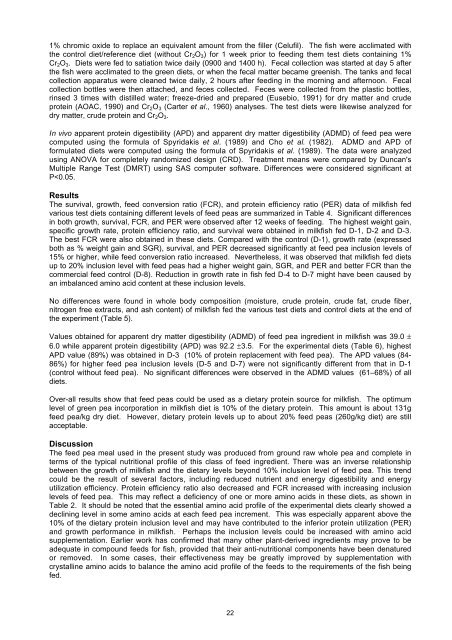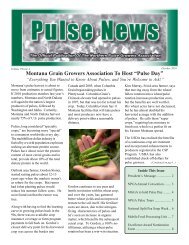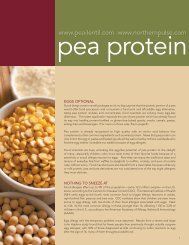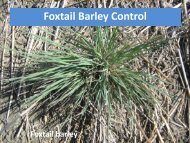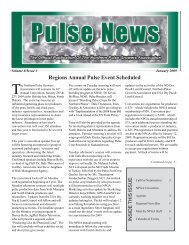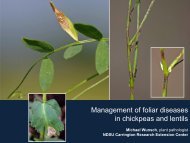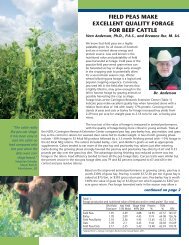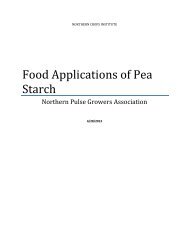experimental <strong>diets</strong> are presented <strong>in</strong> Table 1. All <strong>diets</strong> were <strong>for</strong>mulated to conta<strong>in</strong> 30% prote<strong>in</strong>, 10% lipid<strong>and</strong> energy of about 394kcal/100g diet. Analyses however, showed that experimental <strong>diets</strong> conta<strong>in</strong>ed 33%prote<strong>in</strong> <strong>and</strong> 10% lipid, while the commercial <strong>milkfish</strong> feed control conta<strong>in</strong>ed 37% prote<strong>in</strong> <strong>and</strong> 9% lipid. Thebasal <strong>for</strong>mulation conta<strong>in</strong>ed fish meal, defatted soybean meal, meat <strong>and</strong> bone meal, <strong>and</strong> copra meal asdietary prote<strong>in</strong> sources. The levels of feed pea <strong>in</strong>corporation tested were 0, 5, 10, 15, 20, 25, <strong>and</strong> 30% ofthe total crude prote<strong>in</strong>. Dietary essential am<strong>in</strong>o acid profiles (Table 2) were calculated based on analysesof <strong>in</strong>gredients <strong>and</strong> published data (NRC, 1977) <strong>and</strong> compared to that of requirements <strong>for</strong> <strong>milkfish</strong> juvenile(Borlongan <strong>and</strong> Coloso, 1993) which was used as the reference. Analyzed values of the essential am<strong>in</strong>oacids are likewise presented. No supplemental am<strong>in</strong>o acids were added to the <strong>diets</strong>. Cod liver <strong>and</strong>soybean oils served as lipid sources. Vitam<strong>in</strong> <strong>and</strong> m<strong>in</strong>eral premixes were kept constant <strong>in</strong> all <strong>diets</strong>.Commercial feed peas of US orig<strong>in</strong> were sourced from a local agricultural distributor. The whole dry peawas oven-dried at 60 0 C <strong>for</strong> 4 hours <strong>and</strong> f<strong>in</strong>ely ground to homogenized flour. No specialized <strong>in</strong>gredientprocess<strong>in</strong>g method was used. Diets were prepared by first mix<strong>in</strong>g all dry <strong>in</strong>gredients <strong>in</strong> the Hobart mixer.Oils were then blended with the dry <strong>in</strong>gredient mixture. An equal portion of bread flour was gelat<strong>in</strong>ized bycook<strong>in</strong>g <strong>in</strong> 600 ml water <strong>and</strong> added to the mixture. The semi-moist mixture was then passed through theHobart food gr<strong>in</strong>der to <strong>for</strong>m 2 mm diameter pellets. The pellets were dried <strong>in</strong> an air convection oven at40 0 C. The dry pellets were then ground, sieved to uni<strong>for</strong>m sizes, <strong>and</strong> stored at 4 0 C until used <strong>for</strong> feed<strong>in</strong>g.Experimental fish <strong>and</strong> feed<strong>in</strong>g managementThe experiment was conducted at the <strong>Feed</strong> Development Section of the Aquaculture Department of theSoutheast Asian Fisheries Development Center (SEAFDEC/AQD), Tigbauan, Iloilo, Philipp<strong>in</strong>es. Hatcherybred<strong>milkfish</strong> juveniles were acclimated <strong>for</strong> two weeks under laboratory conditions <strong>and</strong> to a dry diet (controldiet) prior to the experiment. The feed<strong>in</strong>g trials were conducted <strong>in</strong> an <strong>in</strong>door flow-through system. Sixty-litercapacity, oval fiberglass tanks conta<strong>in</strong><strong>in</strong>g 50L seawater with aeration were used. Milkfish juveniles (meanwt. = 0.42 g) were r<strong>and</strong>omly distributed at a stock<strong>in</strong>g rate of 10 fish per tank <strong>and</strong> <strong>in</strong> four replicate tanks pertreatment. Fish <strong>in</strong> each treatment were then fed three times daily at 0830, 1130, <strong>and</strong> 1400H at a feed<strong>in</strong>grate of 10% body weight per day <strong>for</strong> 12 weeks. <strong>Feed</strong><strong>in</strong>g ration was adjusted at every 3 weeks sampl<strong>in</strong>g<strong>in</strong>terval. Water quality parameters (temperature, sal<strong>in</strong>ity, DO, pH, ammonia, nitrite) were monitoredfollow<strong>in</strong>g the methods of Strickl<strong>and</strong> <strong>and</strong> Parsons (1972) to ensure water quality rema<strong>in</strong>ed well with<strong>in</strong> limitsrecommended <strong>for</strong> <strong>milkfish</strong> culture (Bagar<strong>in</strong>ao, 1991).Statistical AnalysesSurvival, % weight ga<strong>in</strong>, specific growth rate (SGR), food conversion ratio (FCR), <strong>and</strong> prote<strong>in</strong> efficiencyratio (PER) were calculated <strong>and</strong> subjected to statistical analyses. Data were subjected to analysis ofvariance (ANOVA) <strong>and</strong> Duncan’s Multiple Range test (DMRT). Differences between means wereconsidered significant at P
1% chromic oxide to replace an equivalent amount from the filler (Celufil). The fish were acclimated withthe control diet/reference diet (without Cr 2 O 3 ) <strong>for</strong> 1 week prior to feed<strong>in</strong>g them test <strong>diets</strong> conta<strong>in</strong><strong>in</strong>g 1%Cr 2 O 3 . Diets were fed to satiation twice daily (0900 <strong>and</strong> 1400 h). Fecal collection was started at day 5 afterthe fish were acclimated to the green <strong>diets</strong>, or when the fecal matter became greenish. The tanks <strong>and</strong> fecalcollection apparatus were cleaned twice daily, 2 hours after feed<strong>in</strong>g <strong>in</strong> the morn<strong>in</strong>g <strong>and</strong> afternoon. Fecalcollection bottles were then attached, <strong>and</strong> feces collected. Feces were collected from the plastic bottles,r<strong>in</strong>sed 3 times with distilled water; freeze-dried <strong>and</strong> prepared (Eusebio, 1991) <strong>for</strong> dry matter <strong>and</strong> crudeprote<strong>in</strong> (AOAC, 1990) <strong>and</strong> Cr 2 O 3 (Carter et al., 1960) analyses. The test <strong>diets</strong> were likewise analyzed <strong>for</strong>dry matter, crude prote<strong>in</strong> <strong>and</strong> Cr 2 O 3 .In vivo apparent prote<strong>in</strong> digestibility (APD) <strong>and</strong> apparent dry matter digestibility (ADMD) of feed pea werecomputed us<strong>in</strong>g the <strong>for</strong>mula of Spyridakis et al. (1989) <strong>and</strong> Cho et al. (1982). ADMD <strong>and</strong> APD of<strong>for</strong>mulated <strong>diets</strong> were computed us<strong>in</strong>g the <strong>for</strong>mula of Spyridakis et al. (1989). The data were analyzedus<strong>in</strong>g ANOVA <strong>for</strong> completely r<strong>and</strong>omized design (CRD). Treatment means were compared by Duncan'sMultiple Range Test (DMRT) us<strong>in</strong>g SAS computer software. Differences were considered significant atP


